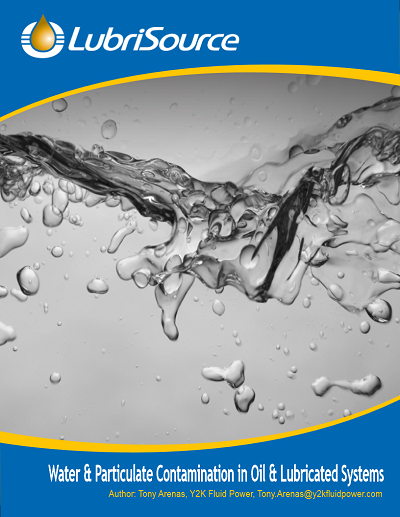In every industrial market, from ag and mining to pulp and paper and power generation, contamination is an issue. LubriSource, Dayton, Ohio, has published a white paper, “Water & Particulate Contamination in Oil & Lubricated Systems” that delves into the problem and offers numerous solutions. It’s authored by Tony Arenas of Y2K Fluid Power, and it explains the challenges: first, understanding cleanliness requirements with specific focus on the most critical wear components; and second, applying the correct filtration system for the application that reduces contamination and stress on these components. Following this advice can extend the normal life cycle up to five times.
 Contamination in various forms is among the highest contributors to system failures and can account for as much as 75 to 85% of the wear that leads to mechanical failure and downtime. There is a growing awareness that proper oil conditioning is proven effective at extending equipment life and increasing productivity, but it still requires dedicated focus, education and a planned approach.
Contamination in various forms is among the highest contributors to system failures and can account for as much as 75 to 85% of the wear that leads to mechanical failure and downtime. There is a growing awareness that proper oil conditioning is proven effective at extending equipment life and increasing productivity, but it still requires dedicated focus, education and a planned approach.
The ingression of moisture and particulate contamination is unavoidable in any type of equipment or machine that uses hydraulic or lube oil. And, says the paper, contamination comes in many forms – even unexpected ones like detergents and chemicals. Different applications, conditions and environments pose a challenge in choosing the correct filtration system — there is no one solution that fits all applications.
To control contamination, the first recommendation is to set cleanliness target levels that reflect reliability goals and application specific requirements. The paper includes a discussion of ISO Cleanliness Codes to aid in the process. Then users should take specific actions to achieve those targets.
For instance, it’s best to keep contaminants out if at all possible. For example, users should filter new oil, install good-quality breathers, upgrade seals and use hydraulic cylinder rod boots. Removing contaminants might require higher-efficiency or better-quality filters, and secondary filtration. That can include:
Spin-on type filters. On mobile two-wheel filter carts or stationary systems, the elements can have varying levels of Beta efficiency ratios. (The higher the Beta number, the higher the efficiency or effective removal the element can capture during a pass.) This is important when sizing, not only to ensure the correct level of cleanliness the system requires but also how fast or efficient it has to be to keep up with the ingression rates. Key points to keep in mind when selecting a filter cart include reservoir volume, required ISO Cleanliness level, type of oil, and the power source.
Depth-type filtration systems. Depth media can come in many forms from point-of-use inline solutions with or without pressure and flow regulating valves to mobile and stationary plug-and-play systems. The paper discusses benefits of using this type of system, how it compares to spin-on products, and where they are recommended.
Membrane technology. The concept behind membrane technology is an oil impermeable membrane inside an opposing directional dry/clean air path to which there is a less-populated cluster of dry air molecules, causing the air molecules to permeate through the membrane and attach to the dry clean air. This is exhausted out as a pure invisible air/water mist. This type of unit is unique in the fact that it can act like a vacuum dehydrator and remove free, emulsified and dissolved water and gasses from the oil.
Vacuum dehydration is by far most effective at rapid water removal. These systems also typically contain some form of particulate removal before returning the oil back to the sump. They use vacuum to lower the effective boiling point of water or emulsions and exhaust them as gas or steam. Vacuum dehydration is used in critical high-cost components or systems that cannot be easily shut down for maintenance, or where the cost of breakdowns exceeds the presumable cost to prevent an unexpected shut down.
Use of secondary filtration is no longer an option that can be put on the back burner when budgets are tight, the paper notes. Properly designed filtration systems increase efficiency, uptime and productivity, but also lower operating costs by reclaiming and extending the useful life of the oil and components and lowering yearly waste oil handling. Simply changing the oil when it is dirty is not enough. In cases where reliability is critical to operations there must be a direct and conscious effort to a good oil management and cleanliness program. For more information, download the complete white paper at the LubriSource web site.
LubriSource
www.lubrisource.com


Leave a Reply